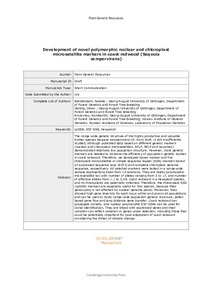Показать сокращенную информацию
Development of novel polymorphic nuclear and chloroplast microsatellite markers in coast redwood (Sequoia sempervirens)
| Автор | Natalie, Breidenbach | |
| Автор | Oliver, Gailing | |
| Автор | Konstantin V. Krutovsky | |
| Дата внесения | 2020-01-20T08:01:50Z | |
| Дата, когда ресурс стал доступен | 2020-01-20T08:01:50Z | |
| Дата публикации | 2019-06 | |
| Библиографическое описание | Natalie, Breidenbach. Development of novel polymorphic nuclear and chloroplast microsatellite markers in coast redwood (Sequoia sempervirens) [Текст] / Breidenbach Natalie, Gailing Oliver, Konstantin V. Krutovsky // Plant Genetic Resources. — 2019. — Т. 17 (№ 3). — С. 293-297 | |
| URI (для ссылок/цитирований) | https://www.cambridge.org/core/journals/plant-genetic-resources/article/development-of-novel-polymorphic-nuclear-and-chloroplast-microsatellite-markers-in-coast-redwood-sequoia-sempervirens/61789D9A387A13D8AA3638356E6946E6 | |
| URI (для ссылок/цитирований) | https://elib.sfu-kras.ru/handle/2311/129604 | |
| Аннотация | The range-wide genetic structure of the highly productive and valuable timber species Sequoia sempervirens (D. Don) Endl. is still insufficiently studied, although published data based on different genetic markers (nuclear and chloroplast microsatellites, AFLP, RFLP and isozymes) demonstrated relatively low population structure. However, more genetic markers are needed to increase the efficiency of population genetic studies in coast redwood. Therefore, we developed seven nuclear and five chloroplast microsatellite or simple sequence repeat (SSR) markers based on expressed sequence tags (ESTs) and complete chloroplast genome sequence, respectively. All selected markers were tested in a range-wide sample representing trees from 16 locations. They are highly polymorphic microsatellite loci with number of alleles ranging from 3 to 17, and number of effective alleles from 1.1 to 2.48. Coast redwood is a hexaploid species, and its chloroplasts are paternally inherited. Therefore, the chloroplast SSR (cpSSR) markers are especially useful for this species, because their genotyping is not affected by nuclear genome ploidy. Moreover, they showed high gene diversity for each locus within and across all populations and can be used to study range-wide population genetic structure, pollen based gene flow and long distance gene transfer. Coast redwood can propagate clonally, and nuclear polymorphic EST-SSRs can be used for clonal identification. They are linked with expressed genes and their variation can reflect variation in genes under selection, including those that could be potentially important for local adaptation of coast redwood considering the threat of climate change. | |
| Тема | coast redwood | |
| Тема | Sequoia sempervirens | |
| Тема | cpSSR | |
| Тема | EST-SSR | |
| Тема | microsatellites | |
| Название | Development of novel polymorphic nuclear and chloroplast microsatellite markers in coast redwood (Sequoia sempervirens) | |
| Тип | Journal Article | |
| Тип | Journal Article Postprint | |
| Страницы | 293-297 | |
| ГРНТИ | 34.15.23 | |
| Дата обновления | 2020-01-20T08:01:50Z | |
| DOI | 10.1017/S147926211800045X | |
| Институт | Институт фундаментальной биологии и биотехнологии | |
| Подразделение | Базовая кафедра защиты и современных технологии мониторинга лесов | |
| Журнал | Plant Genetic Resources | |
| Квартиль журнала в Scopus | Q3 |

